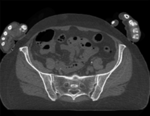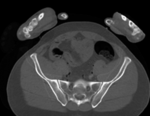Difference between revisions of "Projects:RegistrationLibrary:RegLib C44"
From NAMIC Wiki
(Created page with 'Back to ARRA main page <br> Back to Registration main page <br> [[Projects:RegistrationDocumentation:UseCaseInv…') |
|||
| Line 30: | Line 30: | ||
*moving: CT , 0.6 x 0.6 x 0.40 mm voxel size, axial; 512 x 512 x 107 unsigned short image | *moving: CT , 0.6 x 0.6 x 0.40 mm voxel size, axial; 512 x 512 x 107 unsigned short image | ||
=== Procedure / Pipeline === | === Procedure / Pipeline === | ||
| − | #Open case scene file or import image data: | + | #Open case scene file or import image data: RegLib_C44_SlicerScene.mrml |
| − | # | + | #Overall strategy will be |
| − | # | + | ##use ''vhm'' as fixed, ''vhf'' as moving volume |
| − | # | + | ##because we're interested in the pelvic bone structure differences, we create a mask that will focus the registration on the skeletal region only. |
| − | ## | + | ##perform affine alignment |
| − | ### | + | ##using above affine alignment as starting point, perform low-level BSpline alignment |
| − | ## | + | ##To study the deformation only, extract the BSpline deformation from the transform, i.e. remove the affine portion. This can be done in a text editor, or by first resampling the ''vhf'' volume with the Affine before computing the BSpline. |
| − | ### | + | ##Visualize the deformation by applying the pure BSpline to a [[Projects:RegistrationDocumentation:UseCaseInventory:Auxiliary grid image]] |
| − | # | + | #Change colormap of deformed grid (e.g. hot), window and level to view the gridlines of interest, and overlay on the grayscale images |
| − | ##Go to the [http://www.slicer.org/slicerWiki/index.php/Modules: | + | #Mask generation |
| − | ## | + | ##Go to the [http://www.slicer.org/slicerWiki/index.php/Modules:Editor-Documentation-3.6 Editor module] |
| − | ### | + | ##"Master Volume": select ''vhm'' |
| − | ## | + | ##A new labelmap "vhm-label" will be created |
| − | ## | + | ##Select "vhm" to be visible in the slice viewer |
| − | ### | + | ##Select the ''Threshold'' tool from the editor toolbar |
| − | # | + | ##Adjust the lower threshold (slider bar) until most of the bone is highlighted, e.g. somewhere around an intensity value of 80. Leave the upper threshold unchanged at the max. |
| − | # | + | ##Click Apply |
| − | + | ##Morphologically clean the segmentation: | |
| − | + | ##Run a [http://www.slicer.org/slicerWiki/index.php/Modules:MedianFilter-Documentation-3.6 Median Filter] with a 3x3x3 neighborhood to remove speckle noise | |
| − | ## | + | ##Return to the [http://www.slicer.org/slicerWiki/index.php/Modules:Editor-Documentation-3.6 Editor module] and use the ''Change Island'' tool to remove the segmentation of the arms. |
| − | + | ##Apply 2-3 rounds of morphological dilation to expand the region to include surrounding area. | |
| − | ## | + | ##Rename the labelmap to "vhm_mask" or similar. You will find a "vhm_mask_dil" in the example dataset for comparison |
| − | ## | + | ##Repeat the above segmentation procedure for "vhf" |
| − | #Registration | + | #Registration: |
| + | ##''''Presets''': for either of the registrations below, you can select the "BRAINSFit_...." presets from the parameter set menu instead of setting the parameters manually. | ||
| + | #Affine Registration | ||
##Go to the [http://www.slicer.org/slicerWiki/index.php/Modules:BRAINSFit BRAINSfit module] | ##Go to the [http://www.slicer.org/slicerWiki/index.php/Modules:BRAINSFit BRAINSfit module] | ||
| − | ## | + | ##select the following parameters: |
| − | + | ###''Fixed Image Volume'': vhm ''Moving'': vhf | |
| − | ###''Fixed Image Volume'': | + | ###check boxes for ''Include Rigd registr. phase'' , ''Include ScaleVersor3D'', ''include Affine'' |
| − | ###check boxes for | ||
###''Slicer Linear Transform'': select "create new transform", rename to "Xf1_Affine" or similar | ###''Slicer Linear Transform'': select "create new transform", rename to "Xf1_Affine" or similar | ||
###leave rest at defaults. Click ''Apply'' | ###leave rest at defaults. Click ''Apply'' | ||
###registration should take ~ 10 secs. | ###registration should take ~ 10 secs. | ||
| − | ###use fade slider to verify alignment; compare with result snapshots shown below. | + | ###use fade slider to verify alignment; compare with result snapshots shown below. Alignment will not be perfect but should be better than before. |
| + | #BSpline Registration | ||
| + | ##Go to the [http://www.slicer.org/slicerWiki/index.php/Modules:BRAINSFit BRAINSfit module] | ||
| + | ##select the following parameters: | ||
| + | ###''Fixed Image Volume'': vhm ''Moving'': vhf | ||
| + | ###check boxes for ''Include BSpline registr. phase'' | ||
| + | ###''BSplineTransform'': select "create new transform", rename to "Xf2_BSpline_msk" or similar | ||
| + | ###leave rest at defaults. Click ''Apply'' | ||
=== Registration Results=== | === Registration Results=== | ||
Revision as of 14:04, 12 August 2011
Home < Projects:RegistrationLibrary:RegLib C44Back to ARRA main page
Back to Registration main page
Back to Registration Use-case Inventory
Contents
v3.6.3  Slicer Registration Library Case 44: Visible Human Pelvis CT
Slicer Registration Library Case 44: Visible Human Pelvis CT
Input

|

|

|
| baseline image | follow-up |
Modules
- Slicer 3.6.3 recommended modules: BRAINSFit
Objective / Background
This dataset contains CT of the visible human male and female pelvis. This serves as a test example for exploring non-rigid registration for inter-subject comparison from CT.
Keywords
CT, pelvis, visible human, inter-subject
Issues Challenges
Input Data
- fixed: CT , 0.6 x 0.6 x 0.40 mm voxel size, axial; 292 x 292 x 91 unsigned short image
- moving: CT , 0.6 x 0.6 x 0.40 mm voxel size, axial; 512 x 512 x 107 unsigned short image
Procedure / Pipeline
- Open case scene file or import image data: RegLib_C44_SlicerScene.mrml
- Overall strategy will be
- use vhm as fixed, vhf as moving volume
- because we're interested in the pelvic bone structure differences, we create a mask that will focus the registration on the skeletal region only.
- perform affine alignment
- using above affine alignment as starting point, perform low-level BSpline alignment
- To study the deformation only, extract the BSpline deformation from the transform, i.e. remove the affine portion. This can be done in a text editor, or by first resampling the vhf volume with the Affine before computing the BSpline.
- Visualize the deformation by applying the pure BSpline to a Projects:RegistrationDocumentation:UseCaseInventory:Auxiliary grid image
- Change colormap of deformed grid (e.g. hot), window and level to view the gridlines of interest, and overlay on the grayscale images
- Mask generation
- Go to the Editor module
- "Master Volume": select vhm
- A new labelmap "vhm-label" will be created
- Select "vhm" to be visible in the slice viewer
- Select the Threshold tool from the editor toolbar
- Adjust the lower threshold (slider bar) until most of the bone is highlighted, e.g. somewhere around an intensity value of 80. Leave the upper threshold unchanged at the max.
- Click Apply
- Morphologically clean the segmentation:
- Run a Median Filter with a 3x3x3 neighborhood to remove speckle noise
- Return to the Editor module and use the Change Island tool to remove the segmentation of the arms.
- Apply 2-3 rounds of morphological dilation to expand the region to include surrounding area.
- Rename the labelmap to "vhm_mask" or similar. You will find a "vhm_mask_dil" in the example dataset for comparison
- Repeat the above segmentation procedure for "vhf"
- Registration:
- 'Presets: for either of the registrations below, you can select the "BRAINSFit_...." presets from the parameter set menu instead of setting the parameters manually.
- Affine Registration
- Go to the BRAINSfit module
- select the following parameters:
- Fixed Image Volume: vhm Moving: vhf
- check boxes for Include Rigd registr. phase , Include ScaleVersor3D, include Affine
- Slicer Linear Transform: select "create new transform", rename to "Xf1_Affine" or similar
- leave rest at defaults. Click Apply
- registration should take ~ 10 secs.
- use fade slider to verify alignment; compare with result snapshots shown below. Alignment will not be perfect but should be better than before.
- BSpline Registration
- Go to the BRAINSfit module
- select the following parameters:
- Fixed Image Volume: vhm Moving: vhf
- check boxes for Include BSpline registr. phase
- BSplineTransform: select "create new transform", rename to "Xf2_BSpline_msk" or similar
- leave rest at defaults. Click Apply
Registration Results
 unregistered
unregistered
 registered
registered
 registered
registered
 registered
registered
registered (after flipping axis and cropping volume) registered
Download
- Data
- Presets